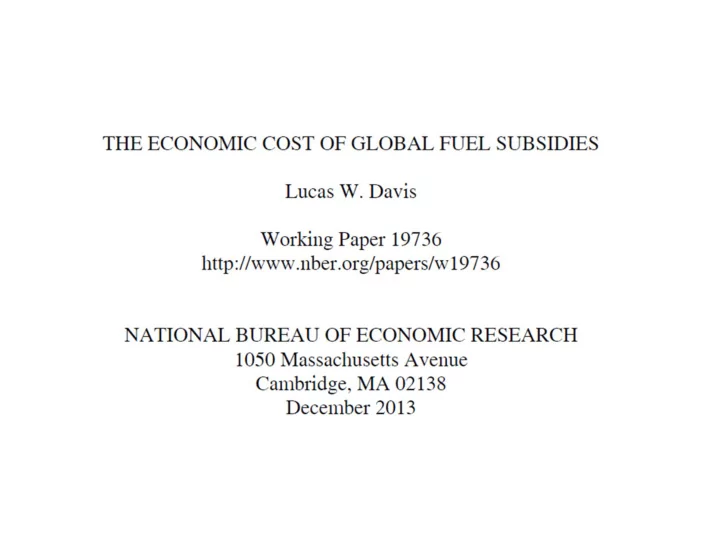

THE ECONOMIC COST OF GLOBAL FUEL SUBSIDIES Lucas W. Davis December 2013 Presented by: Iman Haqiqi
Question: While the opportunity cost of fuel is similar everywhere, why there is a wide variation in price? Nov 2012 Gasoline: Venezuela: $.09 Turkey: $9.00 average: $5.26 Diesel (a bit lower): $0.04 to $7.00, average: $4.12
The answer: • Gasoline consumption tends to be high in countries where gasoline is subsidized. – Saudi Arabia: nine-fold increase in fuels consumption since 1971 – Venezuela :Gasoline consumption per capita in is 40% higher than in any other country in Latin America, and more than three times the regional average.
Measuring Consumption Subsidy The implied subsidy per gallon was calculated as : • – the difference between domestic consumer prices and international spot prices. – Transport, distribution, and retailing costs were incorporated following IMF (2013). The implied subsidy per gallon was then multiplied by road- • sector consumption of each fuel to calculate the total dollar value. By this measure, there are 24 countries that subsidize gasoline, and • 35 countries that subsidize diesel.
Fuel subsidies
Oil producers The top ten countries represent 90% of total global subsidies. Many • of these countries are major oil producers. Fuel subsidies have long been viewed in many oil-producing • countries as a way to share the resource wealth with a nation's citizens. But not in all major oil-producing countries, • – in Iraq ($2.95), – Mexico ($3.26), – Russia ($3.74), and – Canada ($5.00).
Deadweight Loss (DWL) There is DWL for both low prices (subsidy) and high prices (taxes) • Subsidies create deadweight loss by enabling transactions for which the buyer's • willingness-to-pay is below the opportunity cost . The total amount of deadweight loss depends on the elasticities of demand and • supply. In the short-run, demand and supply for crude oil are both inelastic (Hamilton, 2009) – long-run elasticity of demand for transportation fuels: -0.6 to -0.8 – We adopt -0.6 (Total global DWL is 18% higher when -0.8 is used) – Supply is assumed to be perfectly elastic – Incorporating less than perfectly elastic supply would decrease the estimated global – deadweight loss only modestly
Calculations total global deadweight • loss from fuel subsidies in 2012 is $44 billion . Gasoline ($20 billion) and • Diesel ($24 billion). •
DWL by country In 2012, Venezuela • had the cheapest fuels on the planet so even though the • total dollar value of subsidies is higher in Iran and Indonesia, the subsidies in • Venezuela impose more economic cost because the subsidy per gallon is so high •
What about Externalities? Fuel subsidies are different from subsidies in most other markets • because of the substantial external costs. Parry et al. (2007): marginal external damages are $1.11 per • gallon . Carbon dioxide emissions are an important component, but this • also includes – Emissions of local pollutants, – traffic congestion, and – accidents. (many externalities scale by miles traveled)
DWL + Externalities • Eliminating subsidies for gasoline and diesel would, with a -0.6 demand elasticity, decrease global fuel consumption by 29 billion gallons per year. • At $1.11 per gallon this excess consumption imposes external costs worth $32 billion annually • global market for gasoline and diesel was $1.7 trillion in 2012, so $44+$32 billion is 4% of the market
Including Social costs This was the economic cost of pricing fuels below private cost. • An alternative calculation would be to measure the deadweight loss • relative to the full social cost of fuels consumption. This would include the • – deadweight loss ($44 billion) and – external cost ($32 billion) from pricing below private cost, – but also the additional welfare loss from units transacted for which willingness-to-pay is above private cost but below social cost.
Calculations with social costs • Deadweight loss including social costs is $92 billion.
Further studies Expenditures on energy subsidies in many of these countries exceed public • expenditures on health, education , and other key components of government spending. Understanding these social impacts is an important priority for future work. A recent set of international case studies finds that fuel subsidies are not • particularly effective at redistribution (Sterner, ed, 2012), but more work is needed. other energy markets. Fuel subsidies are only one part of a larger set of • energy subsidies. Coal, natural gas, and electricity , for example, are all widely subsidized. Recent analyses of the broader energy sector find that the total dollar value of global energy subsidies is almost $500 billion annually(IEA (2012); IMF (2013))
Thanks
Recommend
More recommend